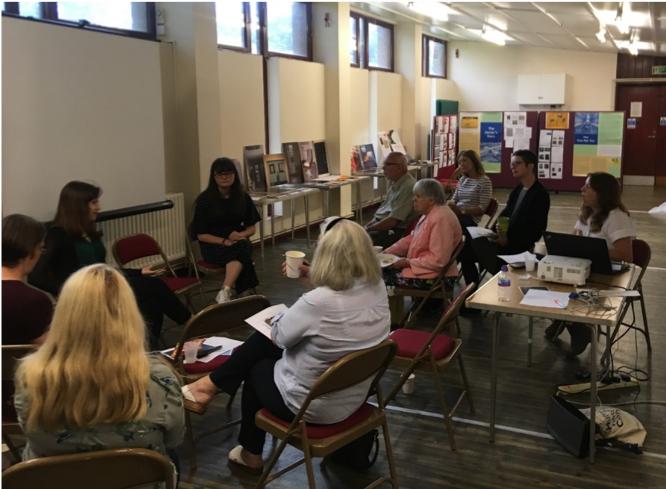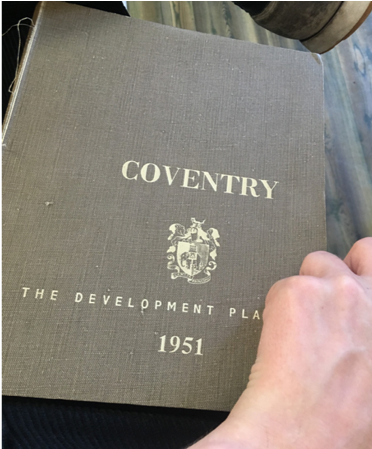by Ed Devane, PhD candidate, University of Warwick
This July marked not only the seventy-first anniversary of the NHS but also one-hundred years of council housing by way of the 1919 Housing, Town Planning Act. Supported by the People’s History of the NHS project, we organised a community history event to pilot the University of Warwick’s ‘The Story of My Street’ project on Saturday 6 July. The purpose of the event and wider project is to explore the overlapping cultures of activism, housing, health, and welfare in the city through the memories and experiences of the city’s people and Coventry’s rich archives. The Basil Spence-designed St Oswald’s Church was an excellent setting. Located on Jardine Crescent, Tile Hill, the event took place on one of the first new municipal estates in Britain to open an NHS Health centre after the Second World War.

At the beginning of the event, two presentations were given by Tara Morten and I on public health in the city before and after the Second World War. We also exhibited a collection of texts and images on the history of hospital care in the city, and a range of student-produced posters on Coventry streets by Isabelle Thibault, Olivia Gallogly-Clements, Katie Gardner and Vlad Marazzi. At the end of the event Professor Roberta Bivins chaired a discussion where respondents asked questions, shared their own family stories, and gave us really valuable feedback and advice!
Attendees especially enjoyed the personal stories within Tara Morton’s presentation which drew on the Mapping Women’s Suffrage database. Tara demonstrated how members of the Coventry Women’s Suffrage Society, such as Averal Constance Wilks, were early critics of the City Council’s lack of nursery and childcare facilities. Suffragists took it upon themselves to establish these services in 1915 when they opened the Tipperary Club in Old Palace Yard. By 1939, and with limited state assistance, similar voluntary welfare centres had spread across fourteen neighborhoods in the city. Amazingly, one of our guests had family connections to Coventry’s suffrage activism, which she kindly shared with us!
I discussed how, post-Appointed Day, such community health services were passed over to Local Health Authorities under the tripartite NHS system. Although this meant health centres could be fully incorporated into postwar plans for areas such as Tile Hill, building restrictions and austerity measures in fact limited their provision exclusively to such new municipal housing estates. Attendees felt strongly about this point, drawing on their own and family experiences. As we have seen at previous ‘NHS History Roadshows’ in other communities, they related it to the present perception of a ‘postcode lottery’ in local services. If recent headlines of a ‘GP Premises Crisis’ are to be believed, it seems this trend has, and will continue to become ever more exaggerated over time as smaller GP Partnership surgeries close around Coventry and across the nation.
Discussions built on the idea that the history of housing and healthcare spoke to the wider equity of space in Coventry. Focusing on Paybody Hospital School in Allesley and Burns Road Occupational Centre in Stoke, Olivia Gallogly-Clements and Isabelle Thibault charted how peripheral health services based physically in the communities they served had been established, repurposed, and wound-down – or replaced with centralized, often less local facilities – since the inception of the NHS.
This trend did not apply solely to healthcare buildings. Vlad Marazzi found that whilst conversion to luxury flats has preserved the 1950s Co-operative and Coventry Evening Telegraph buildings on Corporation Street, non-commercial spaces such as the medieval Church of St John the Baptist remain at risk of disrepair. Attending parishioners confirmed the same was true of Coventry’s three Spence-churches (St Oswald’s, Tile Hill; St John’s, Willenhall; St Chad’s, Wood End) despite their recently listed status.

As the City Council’s postwar plans for Bell Green, Tile Hill, and Radford all placed clinics and surgeries at their centre, I was slightly disappointed (considering my own research focus on NHS buildings) to hear our attendees say that they did not consider them focal points of their community. Instead the consensus seemed to be that local healthcare facilities represent only one barometer of cultural change. Presently, few people felt they had stronger relationships with their own GP or Nurse Practitioner who, it was said, tend to commute rather than reside locally. No NHS staff were represented at the event despite invitations to staff at the Tile Hill Health Centre that had drawn us to the area.
To our delight, one life-long resident of Coventry brought an original copy of the City Council’s 1951 Town Plan. This served as a springboard for a conversation on the successive promises of the Council to ensure a more equitable development of communal amenities. Another attendee felt the increasingly asymmetric distribution of services such as health centres further entrenched division commenting “…Coventry is now an apathetic city … it used to be divided between north and south, now it is a city divided between north, east, south, and west…”.
Katie Gardiner’s research on Stoke Heath’s Belgian refugee community during the First World War refreshed discussions and widened their focus. We all agreed that young families moving to the city have long made Coventry’s population dynamic. However, people sharing similar backgrounds have historically tended to concentrate in certain areas or move and re-concentrate in other neighborhoods as they get older. As a result event’s attendees – whilst making an invaluable contribution – themselves could represent only one small sample of the diversity of active older citizens already engaged in local healthcare and urban planning interest groups. We would love to hear from others who are engaged with the NHS and urban planning from Coventry or elsewhere! Please do get in touch via the comments or at NHShistory@warwick.ac.uk or on twitter @NHS_history!
For me, the Story of the Streets event brought to light issues of division and inequity in the provision of public services. Our guests made it clear that cultures of activism, housing, health, and welfare must not be compartmentalised but considered as a whole. However, I also learned from them that focusing on these themes in one specific neighborhood brought its own limitations. Such a community history event is only ever likely to attract nearby interested parties. If we are to unpick these boundaries further, I would certainly aim to do so in a more open and neutral setting. But without first obtaining their feedback, I would have substantially less understanding of the role of public services in such stories.
Do YOU have memories of the health service in your city, town, village or county that you would like to share? What is your family’s history with health centres and the NHS? Have you or would you like to get involved in something like hospital, clinic or urban planning, to help to shape the place you live? Tell us all about it: we can’t wait to hear from you!


